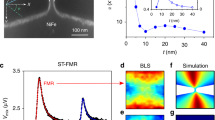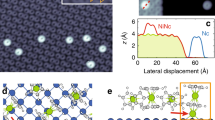Abstract
The properties of quantum systems interacting with their environment, commonly called open quantum systems, can be affected strongly by this interaction. Although this can lead to unwanted consequences, such as causing decoherence in qubits used for quantum computation1, it can also be exploited as a probe of the environment. For example, magnetic resonance imaging is based on the dependence of the spin relaxation times of protons2 in water molecules in a host's tissue3. Here we show that the excitation energy of a single spin, which is determined by magnetocrystalline anisotropy and controls its stability and suitability for use in magnetic data-storage devices4, can be modified by varying the exchange coupling of the spin to a nearby conductive electrode. Using scanning tunnelling microscopy and spectroscopy, we observe variations up to a factor of two of the spin excitation energies of individual atoms as the strength of the spin's coupling to the surrounding electronic bath changes. These observations, combined with calculations, show that exchange coupling can strongly modify the magnetic anisotropy. This system is thus one of the few open quantum systems in which the energy levels, and not just the excited-state lifetimes, can be renormalized controllably. Furthermore, we demonstrate that the magnetocrystalline anisotropy, a property normally determined by the local structure around a spin, can be tuned electronically. These effects may play a significant role in the development of spintronic devices5 in which an individual magnetic atom or molecule is coupled to conducting leads.
This is a preview of subscription content, access via your institution
Access options
Subscribe to this journal
Receive 12 print issues and online access
$259.00 per year
only $21.58 per issue
Buy this article
- Purchase on Springer Link
- Instant access to full article PDF
Prices may be subject to local taxes which are calculated during checkout



Similar content being viewed by others
References
DiVincenzo, D. P. Quantum computation. Science 270, 255–261 (1995).
Damadian, R. Tumor detection by nuclear magnetic resonance. Science 171, 1151–1153 (1971).
Pykett, I. L. et al. Principles of nuclear magnetic resonance imaging. Radiology 143, 157–168 (1982).
Gatteschi, D., Sessoli, R. & Villain, J. Molecular Nanomagnets (Oxford Univ. Press, 2006).
Bogani, L. & Wernsdorfer, W. Molecular spintronics using single-molecule magnets. Nature Mater. 7, 179–186 (2008).
Cohen-Tannoudji, C., Dupont-Roc, J. & Grynberg, G. Atom–Photon Interactions (Wiley, 1992).
Hewson, A. C. The Kondo Problem to Heavy Fermions (Cambridge Univ. Press, 1997).
Loth, S., Baumann, S., Lutz, C. P., Eigler, D. M. & Heinrich, A. J. Bistability in atomic-scale antiferromagnets. Science 335, 196–199 (2012).
Balashov, T. et al. Magnetic anisotropy and magnetization dynamics of individual atoms and clusters of Fe and Co on Pt(111). Phys. Rev. Lett. 102, 257203 (2009).
Gambardella, P. et al. Giant magnetic anisotropy of single cobalt atoms and nanoparticles. Science 300, 1130–1133 (2003).
Hirjibehedin, C. F. et al. Large magnetic anisotropy of a single atomic spin embedded in a surface molecular network. Science 317, 1199–1203 (2007).
Meier, F., Zhou, L., Wiebe, J. & Wiesendanger, R. Revealing magnetic interactions from single-atom magnetization curves. Science 320, 82–86 (2008).
Rusponi, S. et al. The remarkable difference between surface and step atoms in the magnetic anisotropy of two-dimensional nanostructures. Nature Mater. 2, 546–551 (2003).
Tsukahara, N. et al. Adsorption-induced switching of magnetic anisotropy in a single iron(II) phthalocyanine molecule on an oxidized Cu(110) surface. Phys. Rev. Lett. 102, 167203 (2009).
Parks, J. J. et al. Mechanical control of spin states in spin-1 molecules and the underscreened Kondo effect. Science 328, 1370–1373 (2010).
Zyazin, A. S. et al. Electric field controlled magnetic anisotropy in a single molecule. Nano Lett. 10, 3307–3311 (2010).
Höck, M. & Schnack, J. Numerical renormalization group calculations of the magnetization of isotropic and anisotropic Kondo impurities. Phys. Rev. B 87, 184408 (2013).
Otte, A. F. et al. The role of magnetic anisotropy in the Kondo effect. Nature Phys. 4, 847–850 (2008).
Romeike, C., Wegewijs, M., Hofstetter, W. & Schoeller, H. Quantum-tunneling-induced Kondo effect in single molecular magnets. Phys. Rev. Lett. 96, 196601 (2006).
Abragam, A. & Bleaney, B. Electron Paramagnetic Resonance of Transition Ions (Oxford Univ. Press, 2012).
Ashcroft, N. W. & Mermin, N. D. Solid State Physics (Holt, Rinehart & Winston, 1976).
Delgado, F., Palacios, J. J. & Fernández-Rossier, J. Spin-transfer torque on a single magnetic adatom. Phys. Rev. Lett. 104, 026601 (2010).
Khajetoorians, A. A. et al. Current-driven spin dynamics of artificially constructed quantum magnets. Science 339, 55–59 (2013).
Loth, S. et al. Controlling the state of quantum spins with electric currents. Nature Phys. 6, 340–344 (2010).
Slichter, C. P. Principles of Magnetic Resonance (Springer, 1978).
Scalapino, D. Curie law for Anderson's model of a dilute alloy. Phys. Rev. Lett. 16, 937–939 (1966).
Haule, K., Kirchner, S., Kroha, J. & Wölfle, P. Anderson impurity model at finite Coulomb interaction U: Generalized noncrossing approximation. Phys. Rev. B 64, 155111 (2001).
Maltseva, M., Dzero, M. & Coleman, P. Electron cotunneling into a Kondo lattice. Phys. Rev. Lett. 103, 206402 (2009).
Korytár, R., Lorente, N. & Gauyacq, J-P. Many-body effects in magnetic inelastic electron tunneling spectroscopy. Phys. Rev. B 85, 125434 (2012).
Ruggiero, C. D. et al. Emergence of surface states in nanoscale Cu2N islands. Phys. Rev. B 83, 245430 (2011).
Vitali, L. et al. Kondo effect in single atom contacts: the importance of the atomic geometry. Phys. Rev. Lett. 101, 216802 (2008).
Zhang, L., Miyamachi, T., Tomanic, T., Dehm, R. & Wulfhekel, W. A compact sub-Kelvin ultrahigh vacuum scanning tunneling microscope with high energy resolution and high stability. Rev. Sci. Instrum. 82, 103702 (2011).
Horcas, I. et al. WSXM: a software for scanning probe microscopy and a tool for nanotechnology. Rev. Sci. Instrum. 78, 013705 (2007).
Acknowledgements
We acknowledge B. E. M. Bryant, A. J. Fisher, K. J. Franke, A. J. Heinrich, M. Hybertsen, S. Loth and A. F. Otte for discussions and B. E. M. Bryant for support during the experiments. J.F-R. acknowledges the hospitality of the Max-Planck-Institut für Mikrostrukturphysik Halle. Also, J.F-R. is on leave from Departamento de Física Aplicada, Universidad de Alicante, Spain. This work was supported by the Engineering and Physical Sciences Research Council, UK (EP/D063604/1 and EP/H002022/1), Ministry of Science and Education Spain (FIS2010-21883-C02-01, MAT2010-19236, CONSOLIDER CSD2007-0010 and Programa de Movilidad Postdoctoral), European Commission FP7 Programme (PER-GA-2009-251791) and GV grant Prometeo 2012-11.
Author information
Authors and Affiliations
Contributions
J.C.O, M.R.C. and C.F.H. conceived the experiments. J.C.O. and M.R.C. performed the primary experiments and the data analysis, supervised by C.F.H. Additional experiments were performed by J.C.O. with the assistance of M.M. and supervised by D.S. and C.F.H. F.D. performed the perturbative calculations of exchange-induced modification of magnetic anisotropy, as proposed by J.F-R. D.J. implemented and performed the Anderson model calculations in the OCA as proposed by J.F-R. All authors discussed the results and participated in writing the manuscript.
Corresponding author
Ethics declarations
Competing interests
The authors declare no competing financial interests.
Supplementary information
Supplementary information
Supplementary Information (PDF 1863 kb)
Rights and permissions
About this article
Cite this article
Oberg, J., Calvo, M., Delgado, F. et al. Control of single-spin magnetic anisotropy by exchange coupling. Nature Nanotech 9, 64–68 (2014). https://doi.org/10.1038/nnano.2013.264
Received:
Accepted:
Published:
Issue Date:
DOI: https://doi.org/10.1038/nnano.2013.264
This article is cited by
-
Computational design of magnetic molecules and their environment using quantum chemistry, machine learning and multiscale simulations
Nature Reviews Chemistry (2022)
-
Iron phthalocyanine on Au(111) is a “non-Landau” Fermi liquid
Nature Communications (2021)
-
Large magnetic exchange coupling in rhombus-shaped nanographenes with zigzag periphery
Nature Chemistry (2021)
-
Observation of fractional edge excitations in nanographene spin chains
Nature (2021)
-
A new view on the origin of zero-bias anomalies of Co atoms atop noble metal surfaces
Nature Communications (2020)



